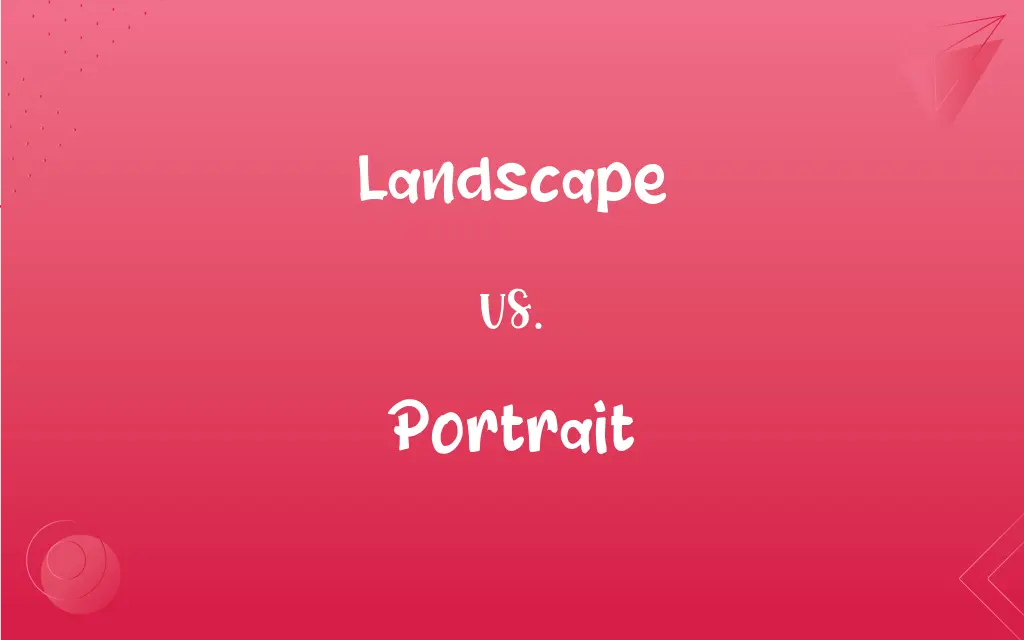Landscape vs. Portrait: What's the Difference?
Edited by Janet White || By Harlon Moss || Updated on October 23, 2023
Landscape is a horizontal orientation; portrait is vertical. Both can also refer to art genres depicting nature and people, respectively.

Key Differences
In terms of orientation, landscape refers to a horizontal alignment, typically wider than its height. Portrait is the opposite, being vertically aligned, taller than its width.
As art genres, landscape focuses on depicting natural scenes like forests, mountains, or beaches. Conversely, portrait is dedicated to representing a person or group of people, capturing their appearance and often their emotions.
When printing or displaying images, landscape is suited for views that stretch out, like sunsets or panoramas. Portrait orientation is apt for tall subjects or when emphasizing height, such as skyscrapers or a standing individual.
In digital devices, switching between landscape and portrait can alter the user experience. For instance, viewing a movie in landscape utilizes screen space efficiently. Reading an e-book in portrait mimics the feel of a traditional book.
To summarize, landscape emphasizes width, either in orientation or in showcasing nature in art. Portrait stresses height in orientation and focuses on depicting individuals or groups in art.
ADVERTISEMENT
Comparison Chart
Orientation
Horizontal
Vertical
Art Genre
Depicts natural scenes
Represents people
Ideal for
Panoramas, wide scenes
Tall subjects, individual figures
Common in
Movies, wide-angle photography
Book reading, individual photography
Emphasizes
Width
Height
ADVERTISEMENT
Landscape and Portrait Definitions
Landscape
All the visible features of an area.
The urban landscape has changed significantly over the decades.
Portrait
The orientation of an image that is taller than it's wide.
The document was printed in portrait mode.
Landscape
A section of rural scenery.
The rolling hills formed a picturesque landscape.
Portrait
A painting, photograph, or drawing of a person.
The portrait captured her smile perfectly.
Landscape
A genre of art focused on natural scenery.
The artist's favorite subject was the tranquil landscape of the countryside.
Portrait
A representation of a particular person.
His portrait hangs in the gallery's main hall.
Landscape
The orientation of an image that is wider than it's tall.
The photograph was taken in a landscape mode.
Portrait
The layout of a printed page that is vertical.
The brochure was designed in a portrait format.
Landscape
The layout of a printed page that is horizontal.
For the presentation, she chose a landscape format.
Portrait
A genre of art dedicated to depicting individuals.
The artist was renowned for his lifelike portraits.
Landscape
An expanse of scenery that can be seen in a single view
A desert landscape.
Portrait
A likeness of a person, especially one showing the face, that is created by a painter or photographer, for example.
FAQs
Is a selfie considered a portrait?
Yes, a selfie is a type of portrait, capturing the image of the person taking it.
Which orientation is common for movies?
Movies are commonly displayed in landscape orientation.
Are all vertical paintings portraits?
No, vertical paintings can depict any subject, but if they're vertical in orientation, they're in portrait format.
What is landscape orientation?
Landscape orientation is horizontal, wider than it's tall.
Can a landscape painting include people?
Yes, landscape paintings can include people, but the main focus remains on the natural surroundings.
Is portrait mode only for photos of people?
No, portrait mode refers to the vertical orientation, regardless of subject.
Can a portrait capture someone's personality?
Yes, portraits often aim to capture not just appearance but also personality and emotion.
What does portrait refer to in art?
In art, portrait refers to a depiction of a person or group of people.
Can landscapes include man-made structures?
Yes, landscapes can include features like bridges or buildings within a natural setting.
What's a group portrait?
A group portrait depicts multiple individuals together in one image.
How does landscape design differ from the art genre?
Landscape design relates to planning outdoor spaces, while the art genre focuses on depicting natural scenes.
Are landscapes only rural scenes?
No, landscapes can depict any natural scene, urban or rural.
How does landscape art differ from a naturalistic painting?
Landscape art specifically focuses on depicting natural scenes, while naturalistic art can include other subjects but aims for realism.
Is landscape mode the default for televisions?
Yes, televisions typically display in landscape mode.
What devices commonly use landscape mode?
Devices like televisions, computer monitors, and movie screens typically use landscape mode.
Can a tablet display in both landscape and portrait?
Yes, tablets can switch between landscape and portrait based on how they're held.
Why might someone choose portrait for photography?
Portrait is chosen to emphasize height or to focus on individual subjects.
Which orientation is standard for documents?
Most standard documents use portrait orientation.
Can portraits be abstract?
Yes, portraits can be abstract, emphasizing elements other than realistic appearance.
Do all cameras have portrait mode?
Many cameras offer portrait mode, especially those designed for versatile photography.
About Author
Written by
Harlon MossHarlon is a seasoned quality moderator and accomplished content writer for Difference Wiki. An alumnus of the prestigious University of California, he earned his degree in Computer Science. Leveraging his academic background, Harlon brings a meticulous and informed perspective to his work, ensuring content accuracy and excellence.
Edited by
Janet WhiteJanet White has been an esteemed writer and blogger for Difference Wiki. Holding a Master's degree in Science and Medical Journalism from the prestigious Boston University, she has consistently demonstrated her expertise and passion for her field. When she's not immersed in her work, Janet relishes her time exercising, delving into a good book, and cherishing moments with friends and family.































































